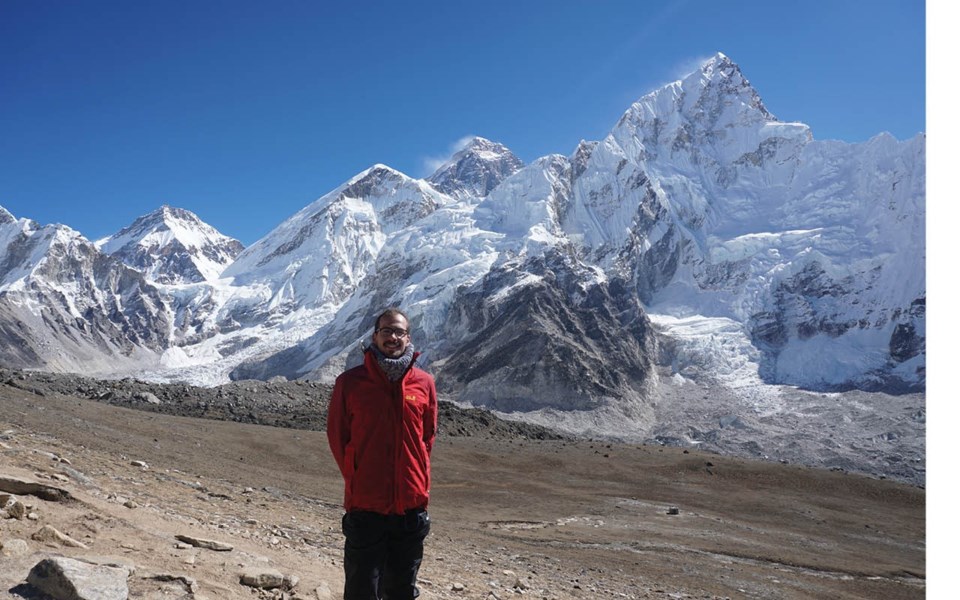It doesn't take much skill to determine that the Sherpa people of the Himalayas are naturally better equipped to travel at high altitudes than people who live at sea level.
After all, their ancestors have lived in a low-oxygen environment above 4,000 metres for around 20,000 years.
Chris McNeil, an assistant professor at the University of British Columbia's School of Health and Exercise Sciences in the Okanagan, and his doctoral student Luca Ruggiero, were hiking to the Pyramid International Laboratory, located at 5,050 metres on Mount Everest in Nepal, when they saw evidence of that firsthand.
"Most of our group was quite fit, but there were a few more support staff who were less familiar with this kind of hiking," McNeil said. "They struggled a bit more. The Sherpa often had to assist these people a fair bit. It was plain as day."
While the cardiorespiratory system of the Sherpa people has been well studied鈥攁nd observed鈥攔esearchers hadn't looked at how their muscles become fatigued after physical strain, and how they recover, compared to lowlanders鈥攑eople who live at sea level.
That was what Ruggiero wanted to look at. "There is not much knowledge on how muscles of Sherpa work and how they actually managed to perform better," Ruggiero said. "If we look at a high-altitude environment with less oxygen (and) transpose these conditions in the clinic (where people are) affected by disease that causes less oxygen in the muscle, or people who have to work in conditions where they can get fatigued sooner in less oxygen, we can understand what makes certain groups perform better at certain altitudes."
Part of the reason this area hasn't been studied is because of the logistical challenges reaching the Pyramid International Laboratory. Its remote location means all equipment has to be hiked in, for one.
While Ruggiero and McNeil were a team of two on their study, another 30 researchers, support staff and Sherpa also travelled to the lab鈥攁dding up to around 9,000 kg of gear that they hiked in on their own and with the help of porters and their yaks.
"The laptops and smaller portable ultrasound machines we brought in our backpacks," McNeil said. "We couldn't risk them getting damaged in the course of the hike."
Once they arrived, the pair had to set up a lab from scratch. "We had pictures on how to reassemble stuff back together because the parts of the brain that are associated with how sharp we are shut off at that altitude," Ruggiero said. "That was one of the biggest challenges."
听
The study involved 10 Sherpa and 12 lowlanders, all in their early 30s. They connected the dominant leg of each person to an isometric dynamometer, which measured the force that their quadriceps exerted. After the participant's strength was determined, they used electrical stimulation to contract their quadriceps鈥攅ssentially mimicking walking鈥攆or four minutes.
Then they measured muscle fatigue as the drop in force from the start of four minutes compared to the end.
What they discovered was the Sherpa participants fatigued 33 per cent less than lowlanders. They also recovered twice as fast.
"The magnitude wasn't as great as we expected," McNeil said. "In a parallel study we tested most of the same lowlanders here in Kelowna before we left in an environment chamber where we simulated the amount of oxygen there would be at the lab. Then we tested again at 5,000 metres for several days. (Lowlanders) performed really well after acclimatization鈥攖o the (point) that we were almost better than ourselves in our natural environment. Perhaps the reason there wasn't as great a difference between the two groups is because the lowlanders had acclimatized in the time they were there."
Still, the findings鈥攚hich were published in The Journal of Physiology last month鈥攕erve as a starting point for future research on the topic and could potentially have an impact on the study of diseases like Chronic Obstructive Pulmonary Disease (COPD).
"One of the possible things we're talking about is testing people who are Sherpa, but have lived, for example in San Francisco鈥攑eople who have the genetic adaptation that comes with being a Sherpa, but don't have the environmental stress," McNeil says. "This is a nature versus nurture question. If we can get enough Sherpa who have lived at sea level their entire lives, we could contrast that with data from people who were born at that altitude and see how much is a genetic component."




